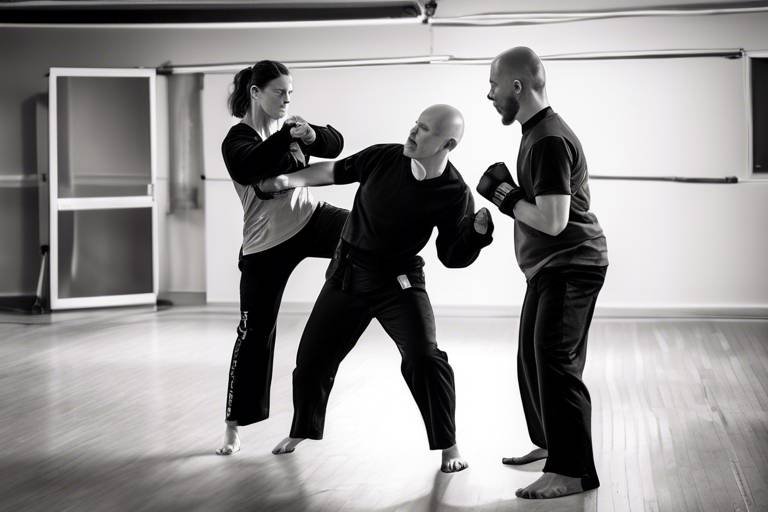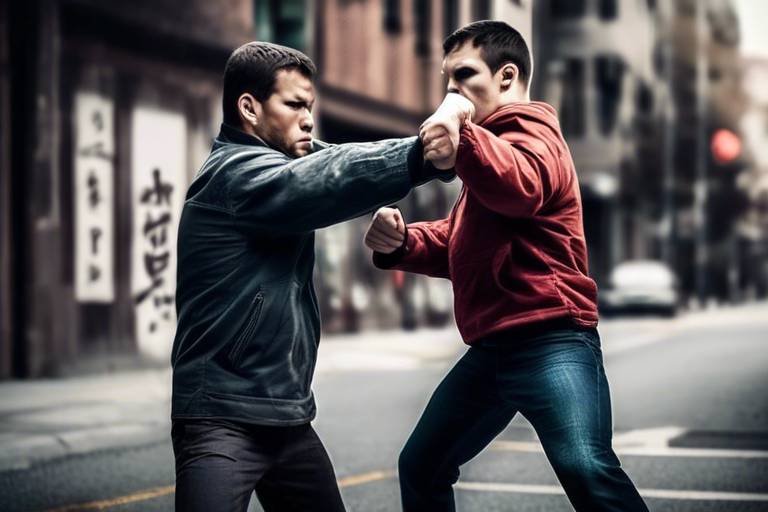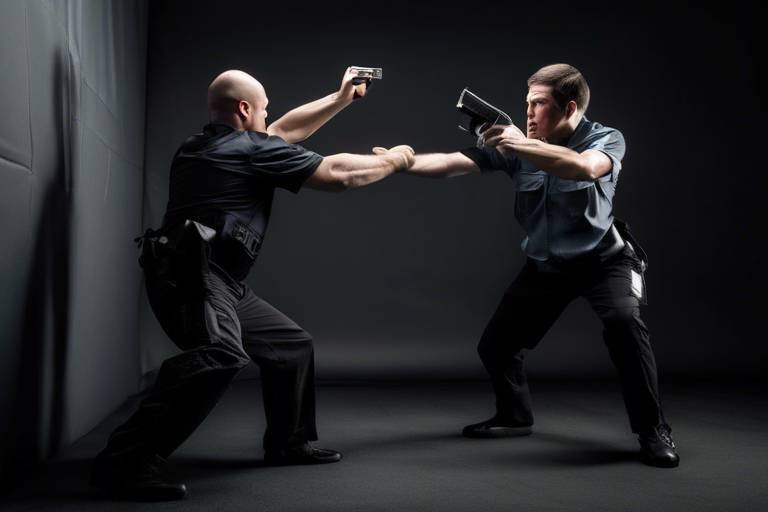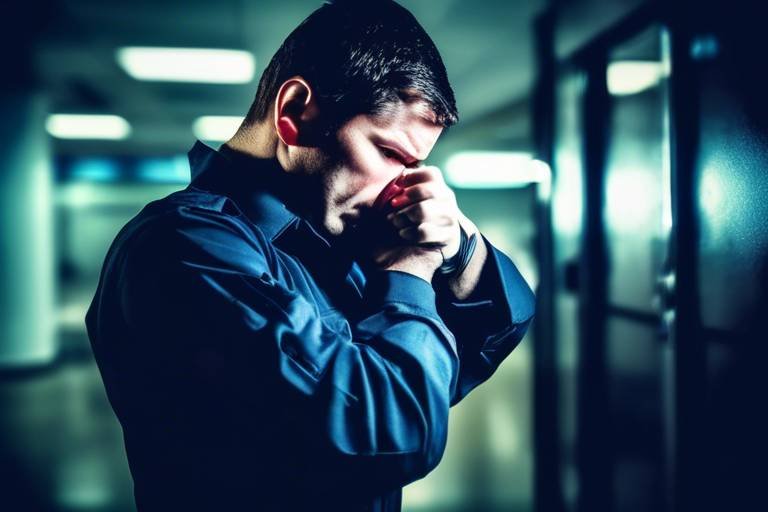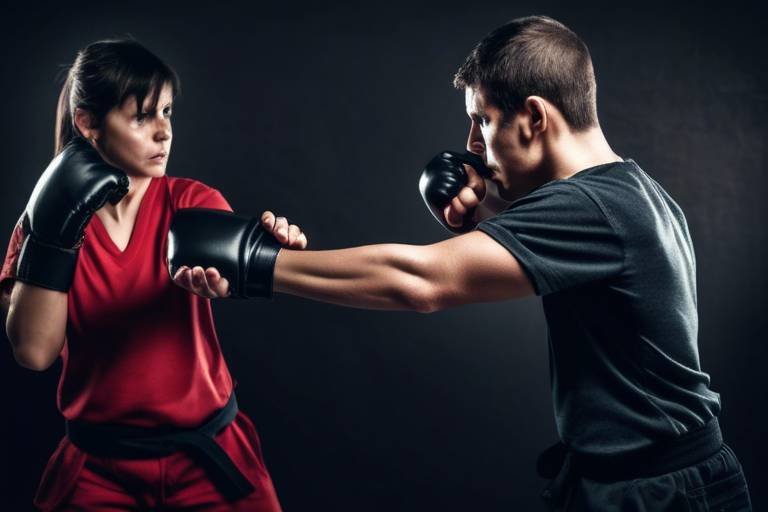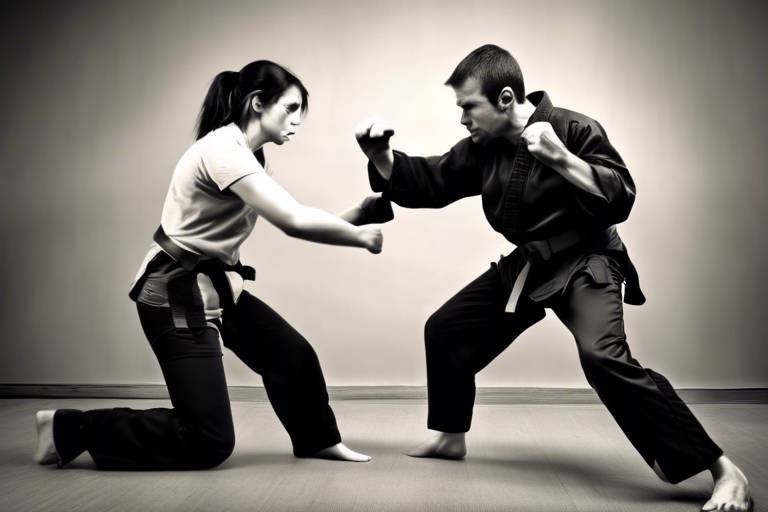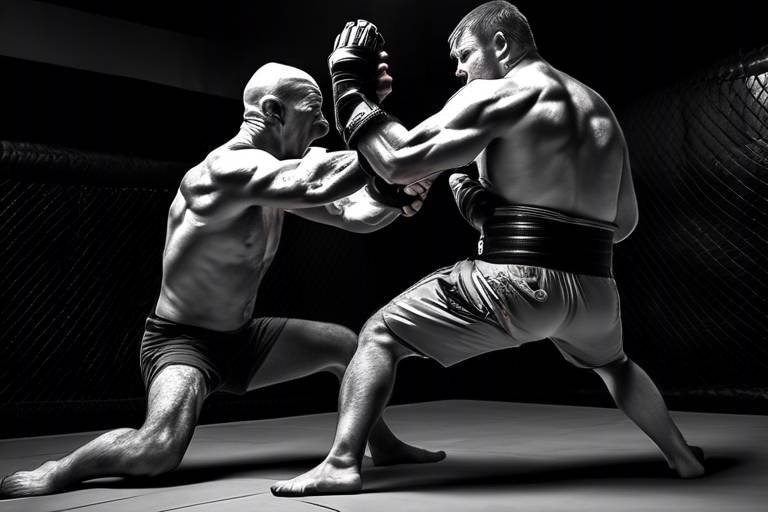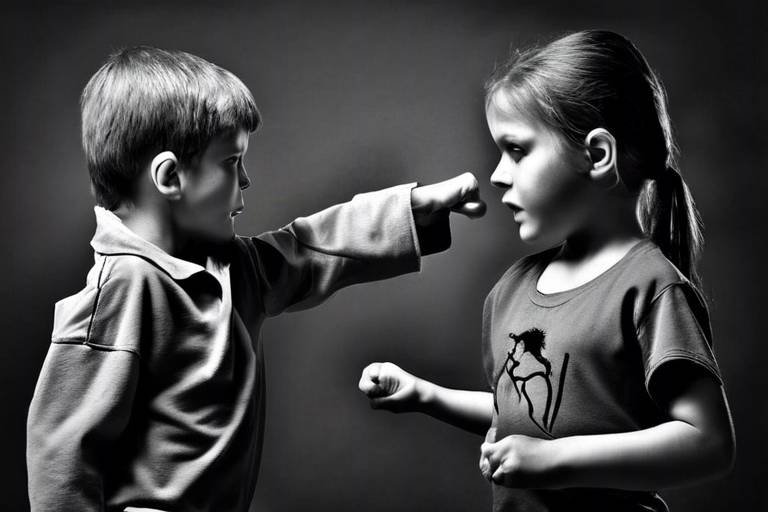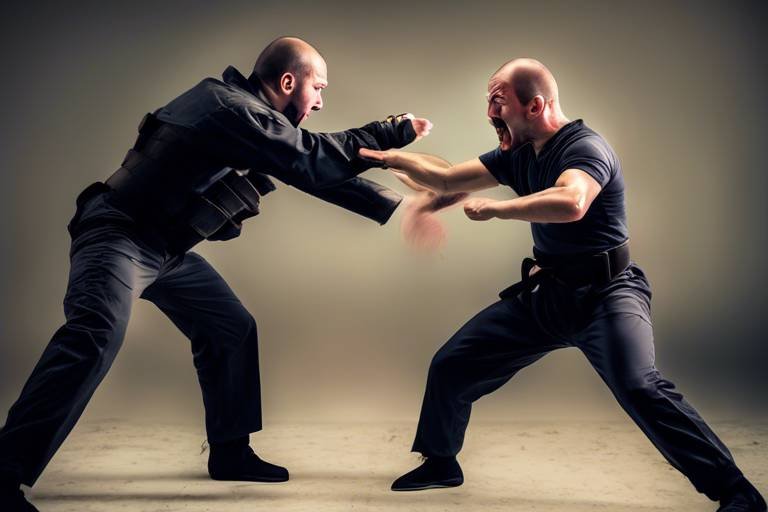Using the Element of Surprise in Self-Defense Scenarios
In a world where personal safety can sometimes feel like a gamble, the element of surprise emerges as a powerful ally in self-defense scenarios. Imagine walking down a dimly lit street when suddenly, an unexpected threat appears. What if you could turn the tables in that moment? By harnessing the element of surprise, individuals can enhance their chances of success and safety, transforming potential danger into an opportunity for escape or defense. This article delves into how surprise can be effectively utilized in self-defense situations, providing you with practical insights and techniques that might just save your life.
Understanding the psychological impact of surprise is crucial for anyone looking to defend themselves. When faced with a sudden threat, both the attacker and the defender experience a rush of adrenaline, altering their reactions and decision-making processes. For the attacker, surprise can lead to overconfidence or hesitation, while for the defender, it can create an opportunity for a decisive counteraction. Think of it like a game of chess; the element of surprise can shift the balance of power in an instant, allowing the defender to seize control of the situation.
Now that we grasp the psychology behind surprise, let’s explore some practical techniques that can be employed to create it during a self-defense encounter. From unexpected movements to deceptive actions, these strategies are designed to catch your attacker off guard and shift the advantage in your favor. Here are some techniques to consider:
One of the most underrated tools in self-defense is body language manipulation. By effectively using your body language, you can mislead an attacker, creating an opening for defense. Subtle cues can signal vulnerability, making an attacker underestimate you while you prepare for a surprise counteraction. For instance, adopting a slouched posture might give the impression of weakness, while your mind is already strategizing your next move.
Feigning weakness is a classic tactic that can lure an attacker into a false sense of security. Picture this: you’re approached by someone who seems intent on causing harm. By appearing defenseless, you can set the stage for a sudden and effective response. This tactic plays on the psychological principle of overconfidence, where the attacker believes they have the upper hand, only to be met with an unexpected counterattack.
Executing unexpected movements can be a game-changer in a self-defense situation. Think of a sprinter at the starting line; the moment the gun goes off, they explode into action. In a similar vein, your physical techniques should be designed to catch the attacker off guard. Whether it’s a sudden pivot, a swift kick, or an unexpected escape route, these movements can disrupt the attacker’s flow and give you the advantage you need to escape safely.
Being aware of your surroundings is another essential factor in utilizing surprise effectively. Your environment can offer numerous opportunities for creating surprise. For example, if you find yourself in a crowded area, you can use the chaos to your advantage, slipping away or using obstacles to shield yourself from an attacker. Additionally, familiarizing yourself with escape routes can turn a potential threat into a mere inconvenience.
While employing surprise in self-defense can be effective, it’s crucial to understand the legal implications of your actions. The last thing you want is to find yourself in legal trouble after a self-defense incident. Knowing the laws that govern self-defense actions is essential to ensure that you stay within legal boundaries. Self-defense is not just about physical prowess but also about being informed and prepared.
An overview of self-defense laws provides insight into what constitutes a legal defense. Each jurisdiction has its own set of rules, so it’s vital to understand the laws in your area. Generally, self-defense is justified when there is an imminent threat, but the response must be proportional. If you’re unsure, it’s wise to seek legal advice to avoid potential repercussions.
Proper documentation and reporting of self-defense incidents are vital. If you ever find yourself in a situation where you need to defend yourself, documenting the encounter can support your legal defense. This includes taking notes immediately after the incident, gathering witness statements, and, if possible, capturing photographic evidence. Remember, the more information you have, the stronger your case will be.
- What should I do if I feel threatened? Always trust your instincts. If you feel threatened, try to remove yourself from the situation and seek help if necessary.
- Are there legal consequences for using self-defense? Yes, the legality of self-defense varies by jurisdiction. It’s important to know your local laws.
- How can I improve my self-defense skills? Consider taking self-defense classes, practicing regularly, and staying aware of your surroundings.

The Psychology of Surprise
Understanding the psychological impact of surprise is crucial for anyone looking to enhance their self-defense skills. When faced with a potential threat, our brains react in fascinating ways. The element of surprise can serve as a double-edged sword, affecting both the attacker and the defender. For the attacker, encountering an unexpected response can lead to confusion and hesitation, drastically altering their planned course of action. On the other hand, for the defender, leveraging surprise can create an opportunity to regain control in a precarious situation.
Surprise can trigger a range of psychological responses, such as fear, panic, or even aggression. When an attacker is caught off guard, their initial reaction may be to retreat or reassess their approach. This momentary pause can provide the defender with a critical advantage. It’s like playing a game of chess; if you can anticipate your opponent’s move and counter it with a surprising strategy, you can shift the game in your favor.
Moreover, the element of surprise can also impact decision-making processes. In high-stress situations, individuals often rely on their instincts rather than rational thinking. This instinctual response can lead to mistakes, especially if the attacker believes they have the upper hand. A well-timed surprise can disrupt their thought process, leaving them vulnerable and open to counterattacks.
To illustrate this further, let’s consider some key psychological effects of surprise:
- Increased Anxiety: An unexpected situation can heighten anxiety levels for both parties involved, leading to impulsive actions.
- Decision Paralysis: The attacker may experience difficulty in making quick decisions, allowing the defender to capitalize on the moment.
- Shift in Control: Surprise can quickly shift the balance of power, giving the defender a chance to regain control.
Ultimately, understanding these psychological dynamics can empower individuals to prepare mentally for self-defense scenarios. By recognizing how surprise affects both themselves and potential attackers, individuals can develop strategies that not only enhance their physical responses but also their mental resilience. It’s about being one step ahead, much like a magician who captivates their audience with unexpected tricks—only in this case, the stakes are much higher.

Techniques to Create Surprise
When it comes to self-defense, employing the element of surprise can be your secret weapon. Imagine being in a situation where an attacker thinks they have the upper hand, only to be met with an unexpected reaction that turns the tables. This is precisely what we’re aiming for. There are various techniques that can help you create surprise during a self-defense encounter, and mastering these can significantly enhance your chances of success.
One of the most effective techniques is body language manipulation. Your body language can communicate a lot, often more than your words. By presenting yourself in a way that suggests vulnerability, you can mislead an attacker into underestimating you. This could involve slouching your shoulders, lowering your gaze, or adopting a non-threatening stance. However, the moment the attacker approaches, you can switch gears and launch a surprise counteraction. Think of it as a chess game where you’re baiting your opponent into making a move that you can easily counter.
Another powerful tactic is feigning weakness. This involves deliberately portraying yourself as defenseless. Picture this: you’re walking alone, and someone approaches you aggressively. Instead of standing tall and ready for a fight, you might hunch over slightly, appearing intimidated. This can create a false sense of security for the attacker. They might think they can overpower you easily, which sets the stage for a surprise counterattack. As soon as they make their move, you can quickly regain your composure and respond with a swift and unexpected action. This tactic not only catches the attacker off guard but also gives you a psychological edge.
Executing unexpected movements is another key strategy in creating surprise. The idea is to break the predictable patterns that attackers often anticipate. For example, if you find yourself in a threatening situation, consider using sudden, agile movements to evade or counter the attack. A quick sidestep followed by a strong defensive maneuver can disorient the attacker. Techniques like these can be practiced in martial arts classes, where instructors teach how to harness your body's natural reflexes. The goal is to make your movements so unpredictable that the attacker can't keep up, allowing you to seize the moment and take control.
Additionally, being aware of your surroundings plays a crucial role in your ability to create surprise. The environment can be your ally. For instance, if you're in a crowded area, using the crowd to your advantage can help you create unexpected barriers or distractions. Whether it’s ducking behind an object or using the terrain to your benefit, environmental awareness can provide countless opportunities to surprise an aggressor. Remember, the element of surprise is not just about what you do; it’s also about where you are and how you can utilize your surroundings to your advantage.
In conclusion, mastering these techniques can significantly enhance your self-defense capabilities. The element of surprise can turn a potentially dangerous situation into a moment where you regain control. By manipulating body language, feigning weakness, executing unexpected movements, and being aware of your environment, you can create a powerful defense strategy that keeps you one step ahead of any threat.
- What is the element of surprise in self-defense? The element of surprise refers to using unexpected actions or behaviors to catch an attacker off guard, increasing your chances of successfully defending yourself.
- How can I practice these techniques? Techniques can be practiced through self-defense classes, martial arts training, or even role-playing scenarios with a partner.
- Is feigning weakness safe? While it can be effective, it’s important to assess the situation carefully. Only use this tactic if you believe it will give you a clear advantage.

Body Language Manipulation
When it comes to self-defense, can be a game-changer. Imagine you're in a tense situation, and your body language is the first thing an attacker notices. The way you stand, your facial expressions, and even your eye contact can send powerful signals. By consciously controlling these signals, you can create an illusion of vulnerability, which might just be the key to turning the tables in your favor. This is not just about physical presence; it's about psychological warfare that can confuse and disarm your opponent.
One effective tactic is to adopt a posture that suggests you are less confident than you actually are. For instance, slumping your shoulders and avoiding direct eye contact can make you appear like an easy target. However, this is all part of a deceptive strategy. Once your attacker feels they have the upper hand, you can swiftly shift your body language to communicate strength and readiness. This sudden change can catch them completely off guard, allowing you to execute your self-defense techniques with the element of surprise.
Consider the following techniques for body language manipulation:
- Open Palms: Displaying your open palms can signal non-aggression, making you appear less threatening.
- Relaxed Stance: A relaxed stance can convey a lack of readiness, luring the attacker into a false sense of security.
- Facial Expressions: A worried or fearful expression can make you look vulnerable, which may encourage an attacker to approach.
However, it’s crucial to be aware of the fine line between appearing vulnerable and actually being defenseless. The moment you sense an attack, your body language should shift dramatically. This sudden transition can create a psychological shock for the attacker, giving you the precious seconds needed to defend yourself effectively. Think of it as a theatrical performance where you play both roles: the victim and the hero. Mastering this art can significantly enhance your self-defense capabilities.
In addition to manipulating your own body language, being observant of your attacker's body language can provide valuable insights into their intentions. If you notice signs of hesitation or uncertainty, it may be your cue to act decisively. Understanding the psychology behind body language can empower you to anticipate movements and reactions, making you a more formidable opponent.
Ultimately, body language manipulation in self-defense is about creating opportunities. By controlling how you present yourself, you can influence the dynamics of the encounter. So, practice these techniques regularly, and remember that confidence can be a powerful weapon when wielded correctly.
- What is body language manipulation in self-defense? It involves controlling your own body language to mislead an attacker and create openings for defense.
- How can I practice body language manipulation? Role-playing scenarios, practicing in front of a mirror, or working with a self-defense instructor can help improve your skills.
- Can body language really make a difference in a self-defense situation? Yes, effective body language can confuse attackers and give you a tactical advantage.

Feigning Weakness
Feigning weakness is a powerful tactic in the realm of self-defense that can dramatically alter the dynamics of an encounter. Imagine a lion that pretends to be injured, luring its prey closer, only to spring into action at the perfect moment. This strategy can be equally effective for individuals facing potential threats. By projecting an image of vulnerability, you can create a false sense of security in your attacker, making them underestimate your capabilities. This psychological manipulation is not just about acting weak; it’s about crafting a narrative that allows you to control the situation.
When you feign weakness, you might adopt a slouched posture or avoid direct eye contact. These subtle cues can signal to your attacker that you are not a threat, encouraging them to lower their guard. However, the key to this tactic lies in timing and execution. You must remain aware of your surroundings and be ready to transition from a position of perceived weakness to one of strength in an instant. This shift can catch your attacker completely off guard, allowing you to execute your self-defense techniques effectively.
Consider this: if an attacker believes they have the upper hand, they may become overconfident, which can lead to critical mistakes. For instance, they might move in closer, thinking they can easily overpower you. This is where your feigned weakness pays off; as they approach, you can initiate a surprise counterattack, using their own momentum against them. This tactic not only enhances your chances of escaping the situation but also empowers you by turning the tables on your aggressor.
It's important to remember, though, that feigning weakness should be used judiciously. It requires a keen understanding of body language and situational awareness. Practicing this technique in a safe environment can help you become more comfortable with the nuances of body language manipulation. For instance, you might practice with a friend, alternating between postures of strength and weakness to see how it feels to shift your demeanor in response to different scenarios.
In conclusion, feigning weakness is not about being deceptive for the sake of it; rather, it’s about leveraging psychological tactics to gain an advantage in a potentially dangerous situation. By mastering this technique, you not only enhance your self-defense skills but also cultivate a mindset that is adaptable and resilient in the face of threats.

Unexpected Movements
When it comes to self-defense, one of the most powerful tools in your arsenal is the element of . Imagine being in a situation where your heart races, and your instincts kick in. This is where the magic happens. By executing movements that catch an attacker off guard, you can turn the tables in your favor, creating an opportunity to escape or defend yourself effectively.
So, what exactly are unexpected movements? Think of them as the wild card in a card game; they disrupt the expected flow and create chaos for your opponent. For instance, instead of a standard punch or kick, you might suddenly drop low and sweep their legs, or feint to one side before quickly shifting to the other. These surprise maneuvers can disorient an attacker, giving you precious seconds to act.
Here are a few techniques that can help you master the art of unexpected movements:
- Body Shifts: By shifting your weight quickly from one foot to another, you can create the illusion of movement that confuses your attacker.
- Spins and Turns: A sudden spin can not only evade an attack but also position you for a counterstrike.
- Changes in Level: Going from standing to crouching or even rolling can throw off your opponent’s aim and timing.
It’s essential to practice these movements regularly to ensure they become second nature. The more you rehearse, the more instinctual these actions will be in a high-pressure situation. Think of it like learning to ride a bike; at first, it feels awkward, but eventually, you glide effortlessly.
Moreover, your environment plays a crucial role in how you execute unexpected movements. For instance, if you find yourself in a crowded area, using the space around you—like walls or furniture—can enhance your surprise tactics. This not only provides cover but also allows you to use objects as shields or barriers, making it harder for an attacker to predict your next move.
In conclusion, incorporating unexpected movements into your self-defense strategy can significantly enhance your chances of success. By practicing these techniques and being aware of your surroundings, you can become a formidable opponent, even against someone who may appear stronger or more aggressive. Remember, in self-defense, it’s not just about brute strength; it’s about being smart, quick, and unpredictable.
- What are unexpected movements in self-defense? Unexpected movements refer to actions that catch an attacker off guard, allowing the defender to gain an advantage.
- How can I practice unexpected movements? Regular training, drills, and sparring sessions can help you become more proficient in executing these movements instinctively.
- Do I need special training to use unexpected movements? While formal martial arts training can be beneficial, anyone can learn basic techniques through self-defense classes or instructional videos.
- Can unexpected movements work against larger attackers? Yes, the element of surprise can be effective against attackers of any size, as it disrupts their expectations and reactions.

Environmental Awareness
When it comes to self-defense, being aware of your surroundings can be a game changer. Imagine walking down a street, your mind occupied with thoughts of the day, when suddenly, you sense something is off. This is where becomes your best friend. It’s not just about being vigilant; it’s about understanding how your environment can either help or hinder you in a potentially dangerous situation.
First off, let’s talk about the importance of recognizing potential escape routes. In any self-defense scenario, having an exit plan can significantly increase your chances of getting away safely. Always scan your surroundings for exits and obstacles. Are there nearby buildings, alleys, or open spaces? Knowing where you can go in an emergency can provide that critical edge. For example, if you find yourself cornered, knowing that there’s a nearby store you can dart into can make all the difference.
Additionally, the environment can serve as a tool for surprise. Think about it: if you’re aware of your surroundings, you can use elements like shadows, corners, and even objects to your advantage. Let’s say you’re approached by someone who seems threatening. If you’re near a large object, like a car or a bench, you can position yourself to use it as a barrier. This not only gives you a physical advantage but can also disorient your attacker, giving you a moment to act.
Moreover, environmental awareness includes understanding the people around you. Are there others nearby who could help? Are there witnesses who might deter an attacker? Sometimes, the mere presence of other people can be enough to shift the dynamics of a situation. By being observant, you can gauge whether someone is a potential ally or a threat.
Finally, let’s not forget about the element of surprise that can be derived from environmental factors. For instance, if you’re in a crowded area, the noise and movement can work to your advantage. An attacker may not expect you to react swiftly because they assume they have the upper hand in a chaotic environment. By being aware and prepared, you can turn the tables in your favor. Remember, the goal is to create a moment of confusion for the attacker, allowing you to escape or defend yourself effectively.
In summary, environmental awareness isn’t just about keeping your head on a swivel; it’s about actively engaging with your surroundings to enhance your self-defense capabilities. By understanding your environment, recognizing potential escape routes, and utilizing objects and people to your advantage, you can significantly improve your chances of staying safe in a threatening situation.
- What is environmental awareness in self-defense?
Environmental awareness refers to being conscious of your surroundings, understanding potential threats, escape routes, and how to use the environment to your advantage during a self-defense situation. - How can I improve my environmental awareness?
You can enhance your environmental awareness by practicing mindfulness, regularly scanning your surroundings, and engaging in situational awareness exercises. - Why is environmental awareness important in self-defense?
Being aware of your environment allows you to identify potential threats, escape routes, and opportunities to use your surroundings to your advantage, which can significantly increase your safety.

Legal Considerations
When it comes to self-defense, understanding the legal implications of your actions is paramount. It's not just about protecting yourself; it's also about ensuring that your response to a threat aligns with the law. The laws surrounding self-defense can vary significantly from one jurisdiction to another, which means that what might be considered a justified response in one place could land you in serious legal trouble in another. So, how do you navigate these murky waters while still being prepared to defend yourself?
First and foremost, it’s essential to grasp the concept of reasonable force. This term refers to the level of force that is deemed appropriate in a given situation. Generally, the law allows individuals to use reasonable force to protect themselves, but this force must be proportional to the threat faced. For instance, if someone is merely shoving you, responding with lethal force would likely be viewed as excessive. Understanding this balance is crucial, as it can mean the difference between a justified defense and a criminal charge.
Moreover, the concept of imminent threat is vital. Self-defense is typically justified only when there is an immediate threat of harm. This means that if an attacker is merely making threats from a distance, the law may not justify a physical response. In such cases, it’s often advisable to seek a way to escape rather than engage. Knowing the nuances of what constitutes an imminent threat in your area can help you make informed decisions in critical moments.
To further complicate matters, there are also laws regarding the use of deadly force. In many places, the law permits the use of deadly force only when there is a reasonable belief that it is necessary to prevent imminent death or serious bodily harm. This means that if you find yourself in a self-defense scenario, you need to assess the situation quickly and determine whether the threat warrants such a response. Failure to do so could lead to severe legal consequences.
Additionally, documenting any self-defense encounter is crucial. If you find yourself in a situation where you had to defend yourself, proper documentation can support your legal defense. This includes taking notes about the incident, gathering witness statements, and, if possible, collecting any video evidence. The more detailed your account, the better your chances of demonstrating that your actions were justified under the law.
In summary, being prepared for a self-defense situation isn't solely about physical readiness; it’s also about understanding the legal landscape. Familiarizing yourself with local self-defense laws, the concept of reasonable force, and the importance of documentation can significantly impact the outcome of an encounter. Always remember, while the element of surprise can be a powerful tool in self-defense, it must be wielded with a clear understanding of the legal ramifications.
- What should I do immediately after a self-defense incident? It's crucial to seek safety, call the police, and then document everything about the incident.
- Can I use self-defense if I provoked the attacker? This can depend on the circumstances, but generally, if you feel threatened, you may still have a right to defend yourself, though it can complicate your legal standing.
- Do I need to retreat if I can? Some jurisdictions have a "duty to retreat" law, meaning you must attempt to escape before using force. Know your local laws.

Self-Defense Laws Overview
When it comes to self-defense, understanding the law is as crucial as knowing how to execute a proper technique. Self-defense laws vary significantly from one jurisdiction to another, making it essential for individuals to familiarize themselves with the legal framework that governs their actions. Generally speaking, these laws are designed to allow individuals to protect themselves from imminent harm, but they also come with specific conditions that must be met to ensure that the use of force is deemed justifiable.
In most places, self-defense is justified when an individual reasonably believes that they are facing an immediate threat of violence. This belief must be based on the circumstances surrounding the encounter. For instance, if an attacker approaches you aggressively and you feel threatened, you may be justified in using force to protect yourself. However, the level of force used must be proportional to the threat faced. This means that if someone pushes you, responding with lethal force would likely be considered excessive and could lead to legal consequences.
To navigate these complex laws, it’s beneficial to be aware of the following key principles:
- Immediacy of Threat: The threat must be immediate and unavoidable. If the danger has passed, using force may not be justified.
- Proportionality: The response must be proportional to the threat. Using excessive force can lead to legal repercussions.
- Duty to Retreat: Some jurisdictions require individuals to retreat from a threat if it is safe to do so before using force, while others support the "stand your ground" principle.
Understanding these principles is vital for anyone interested in self-defense. It’s also important to note that the burden of proof often lies with the defender to demonstrate that their actions were justified. This is where proper documentation and immediate reporting of the incident become crucial. If an individual is involved in a self-defense situation, having a clear account of the events can help substantiate their claim in a legal context.
Moreover, it’s advisable to consult with a legal expert or take self-defense classes that include legal education. Many self-defense instructors emphasize the importance of knowing the law, equipping their students not only with physical skills but also with the knowledge needed to navigate potential legal challenges.
In summary, while self-defense laws are designed to protect individuals, they come with specific guidelines that must be adhered to. By understanding these laws and preparing accordingly, individuals can ensure that they are not only ready to defend themselves but also remain within legal boundaries.
- What should I do immediately after a self-defense incident?
It’s crucial to seek safety first, then call the authorities. Document the incident as thoroughly as possible. - Can I use self-defense if I started the confrontation?
Generally, if you initiated the confrontation, your right to claim self-defense may be limited. However, if the situation escalates and you genuinely fear for your safety, you may still have a case. - Do I need to report a self-defense incident?
Yes, it’s advisable to report any self-defense incident to the police to create an official record, which can be crucial for any potential legal proceedings.

Documentation and Reporting
When it comes to self-defense, the aftermath of an incident can be just as critical as the event itself. Proper documentation and reporting of what transpired can significantly impact the legal outcomes following a confrontation. Imagine this: you've successfully defended yourself, but without a clear record of the event, your version of the story may not hold up in court. Therefore, it’s essential to understand how to effectively capture and communicate the details of your encounter.
First and foremost, immediately after an incident, your priority should be to ensure your safety and the safety of others. Once the situation has stabilized, begin documenting everything you can remember. This includes the time, location, and any witnesses present. Use your smartphone to take photos of the scene, your injuries, or any damage that occurred. Visual evidence can be incredibly powerful in supporting your account of the events.
Next, write down a detailed account of what happened while the memory is still fresh. Include specifics such as:
- The sequence of events leading up to the confrontation
- The actions taken by both you and the attacker
- Your emotional state and any verbal exchanges
- Any environmental factors that may have influenced the situation
This written record will serve as a crucial piece of evidence should you need to defend your actions legally. Remember, the goal is to create a clear narrative that can be easily understood by law enforcement and legal representatives.
Additionally, it’s vital to report the incident to the police as soon as possible. When speaking to law enforcement, stick to the facts and avoid embellishing details. Your aim is to provide a concise and accurate account of what occurred. Be prepared to answer questions about your actions and the perceived threat you faced. This is where your documentation can come in handy; referring to your notes can help you stay consistent in your story.
Finally, if you find yourself in a legal battle following a self-defense incident, consider consulting with a lawyer who specializes in self-defense cases. They can guide you on how to best present your documentation and help you navigate the complexities of the legal system. Remember, the right legal support can make all the difference in ensuring your actions are understood and justified.
Q: Why is documentation important after a self-defense incident?
A: Documentation provides a factual account of the incident, which can be crucial in legal proceedings. It helps establish your version of events and supports your claims of self-defense.
Q: What should I include in my documentation?
A: Include details such as the time and place of the incident, descriptions of the attacker, your actions, any witnesses, and any evidence such as photographs or videos.
Q: Should I contact a lawyer after a self-defense incident?
A: Yes, consulting with a lawyer can help you understand your rights and obligations, and they can provide guidance on how to navigate any legal challenges that may arise.
Frequently Asked Questions
- What is the element of surprise in self-defense?
The element of surprise in self-defense refers to using unexpected actions or tactics to catch an attacker off guard. This can significantly increase the chances of successfully defending oneself in a threatening situation.
- How can surprise affect the psychology of an attacker?
Surprise can disrupt an attacker's mental state, causing confusion and hesitation. When an attacker is caught off guard, their decision-making process can falter, giving the defender a crucial advantage to escape or counterattack.
- What techniques can I use to create surprise during an encounter?
There are several techniques to create surprise, including:
- Feigning weakness to lure the attacker.
- Executing unexpected movements, like sudden shifts in position.
- Using body language to mislead the attacker about your intentions.
- Why is environmental awareness important in self-defense?
Being aware of your surroundings allows you to identify potential escape routes or objects that can be used for defense. This knowledge can help you plan your actions and create opportunities to surprise an attacker.
- What legal considerations should I be aware of when using surprise in self-defense?
It's crucial to understand local self-defense laws, as they dictate what actions are legally permissible. Using surprise must be justified within the legal framework to avoid potential legal repercussions.
- How should I document a self-defense incident?
Documentation should include a detailed account of the incident, witness statements, photographs of injuries or the scene, and any other relevant evidence. This documentation can be vital in supporting your legal defense if needed.


